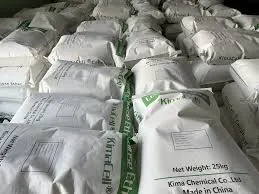
Dec . 12, 2024 09:56 Back to list
use of hydroxypropyl methylcellulose
The Use of Hydroxypropyl Methylcellulose Applications and Benefits
Hydroxypropyl Methylcellulose (HPMC) is a widely utilized cellulose derivative known for its versatility and effectiveness in various industries. As a non-ionic, water-soluble polymer, HPMC plays a critical role in improving the physical properties of numerous products, ranging from pharmaceuticals to food, construction, and personal care items. This article explores the applications, benefits, and significance of HPMC in different sectors.
1. Pharmaceutical Applications
HPMC is especially valued in the pharmaceutical industry for its use as a binder, thickening agent, and film-former in tablet formulations. Its ability to improve the viscosity and stability of formulations makes it an essential component in both solid and liquid dosage forms. HPMC is often used in controlled-release drug formulations, where it regulates the release of active pharmaceutical ingredients over an extended period. This tailored release mechanism can enhance patient compliance by reducing the frequency of dosing.
Additionally, HPMC serves as an excipient in various formulations, including eye drops and gels. Its optical clarity and mucoadhesive properties ensure that the formulations remain effective and provide the necessary comfort for users. In the realm of ophthalmology, the use of HPMC in ocular solutions is critical for maintaining moisture and preventing dryness, which can be particularly beneficial for patients with conditions such as dry eye syndrome.
2. Food Industry Applications
In the food industry, Hydroxypropyl Methylcellulose is recognized as a food additive, classified as E464 in Europe. Its primary applications involve its use as a thickener, emulsifier, and texturizer. HPMC is commonly found in gluten-free products as it helps improve the texture and moisture retention of baked goods, contributing to a pleasing mouthfeel.
Moreover, HPMC's emulsifying properties aid in stabilizing oil-water emulsions in sauces, dressings, and dairy products. Its water-holding capacity also ensures that food products maintain their quality and freshness over time. As consumers increasingly seek healthier and low-fat food options, HPMC emerges as a vital ingredient enabling manufacturers to create products with desirable textures without compromising flavor.
use of hydroxypropyl methylcellulose

3. Construction Industry Applications
The construction industry significantly benefits from the properties of Hydroxypropyl Methylcellulose. It is commonly used as an additive in cement, mortar, and tile adhesives. The inclusion of HPMC improves workability, enhances adhesion, and extends the open time of these materials. With its capacity to retain water, HPMC aids in preventing premature drying of cement mixes, which can lead to cracking and compromised structural integrity.
Moreover, HPMC's rheological properties allow for smoother application and better performance of construction materials, ensuring a high-quality finish in building projects. This versatility underscores its importance in modern construction practices.
4. Personal Care and Cosmetics
In personal care and cosmetic products, HPMC functions as a thickener, stabilizer, and film-forming agent. Its ability to enhance the texture of creams, lotions, and gels contributes to improved user experience. HPMC also acts as a stabilizer in emulsions, preventing separation and ensuring a homogenous product.
Furthermore, HPMC is utilized in hair care products where it can provide conditioning effects and improve the overall performance of the formulation. Its non-irritating nature makes it an attractive ingredient for skin care products, allowing for a gentle application suitable for sensitive skin types.
Conclusion
Hydroxypropyl Methylcellulose stands out as a multifunctional polymer with applications that span various industries, including pharmaceuticals, food, construction, and personal care. Its unique properties, such as water solubility, viscosity enhancement, and emulsification capabilities, contribute significantly to improving product quality and performance. As industries continue to innovate and adapt to consumer needs, HPMC will likely remain a vital ingredient, fostering advancements in product formulations and enhancing the overall efficacy of various applications.
-
Versatile Hpmc Uses in Different Industries
NewsJun.19,2025
-
Redispersible Powder's Role in Enhancing Durability of Construction Products
NewsJun.19,2025
-
Hydroxyethyl Cellulose Applications Driving Green Industrial Processes
NewsJun.19,2025
-
Exploring Different Redispersible Polymer Powder
NewsJun.19,2025
-
Choosing the Right Mortar Bonding Agent
NewsJun.19,2025
-
Applications and Significance of China Hpmc in Modern Industries
NewsJun.19,2025







